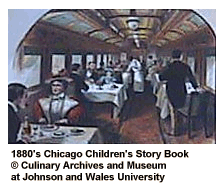|
1865-1874 1865 End of American Civil War; 1866 First Chisholm Trail cattle drive (Texas to Abilene, Kansas); Tin can with key opener patented; 1867 Sale of frankfurters in a roll or bun (Coney Island, New York); Barbed wire patented; 1868 Commercial yeast developed; Dining car invented; Refrigerated railcar patented; 1869 Transcontinental railroad completed (Promontory Point, Utah); 1870 Rotary egg beater invented; 1871 Iced tea served (Fifth Avenue Hotel, New York); Great Chicago fire (relief supplies sent by railroad); 1872 Flat-bottomed paper bag patented; First national park established (Yellowstone); 1873 Thermos bottle invented; 1874 Margarine introduced. 1875-1879 1875 Apples grown in American northwest (Yakima Valley, Washington); Combines first used to harvest wheat; 1876 Fred Harvey restaurant opens (Santa Fe railroad depot, Topeka, Kansas); Centennial Exposition, Philadelphia; Telephone invented (Alexander Graham Bell); 1877 Chief Joseph?s war with United States; Phonograph invented (Thomas A. Edison); 1878 Roasted coffee packed in sealed cans; Bottle stopper patented; 1879 Milk bottle developed (Brooklyn, New York); First public electric street lighting (Cleveland, Ohio). 1880-1884 1880 Peak of Chisholm Trail cattle drives; Incandescent lamp (light bulb) invented (Thomas Alva Edison); 1881 Anthrax vaccine developed (Louis Pasteur); American Red Cross founded; 1882 Electric streetlights installed (New York); Electric iron invented (Henry Seely); Electric fan invented (Schuyler Skaats Wheeler); 1883 Standard time adopted; 1884 Telephone service inaugurated between New York and Chicago; Steel girders first used in building construction. |
Only fools argue with skunks, mules, or cooks.....
|
1885-1889 1885 Cattle drives decline; 1886 Aluminum processing developed; Statue of Liberty dedicated (Bedloe?s Island, New York); 1887 Land grant universities established (Hatch Act); 1888 Fred Harvey dining cars introduced on westbound Santa Fe trains; Secret ballot first used in America; First electric automobile demonstrated (Boston, Massachusetts); 1889 Movie film developed (Thomas Alva Edison and George Eastman); Johnstown flood (2295 drowned); Montana admitted into the Union (41st state). 1890-1899 1890 Peanut butter invented; Aluminum cooking ware introduced; 1891 Wireless telegraph (telephone) patented (Thomas A Edison); Motion picture camera patented (Thomas A. Edison); Vacuum lamp patented (Thomas A. Edison); 1892 Ellis Island (New York) opened to receive immigrants; 1893 Zipper invented (Whitcomb L. Judson); World Columbian Exposition (Chicago, Illinois); First successful gasoline engine (Henry Ford); 1894 Labor Day declared legal holiday; 1895 First automobile race; 1896 First x-ray treatment for breast cancer; Ford automobile developed; Klondike gold strike; Olympic games revived (Athens); 1897 John Philips Sousa (Stars and Stripes Forever); 1898 Spanish-American War begins and ends; 1899 Popularity of ragtime (Scott Joplin). 1900-1910 1900 Colorado River used to irrigate Imperial Valley, California; 1901 Spindletop oil strike (Beaumont, Texas); Instant coffee invented; Yellow fever associated with mosquito; 1902 Panama Canal financed; 1903 First powered airplane flight (Orville and Wilbur Wright); First transcontinental automobile trip (51 days); 1904 World?s Fair (St. Louis, Missouri). 1905 The Jungle published by Upton Sinclair; 1906 San Francisco earthquake and fire; Valencia oranges grown for first time in California; Pure Food and Drug Act passed by Congress; First trans-Atlantic radio transmission; 1908 First cafeteria opened (Los Angeles, California); Cellophane invented; Electric toaster introduced; 1909 Model T Ford introduced; NAACP founded; 1910 Return of Haley's Comet. |
|||
|
|||||
| Exhibit Home | Further Resources | Library Home |
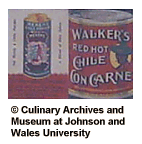 Trail cooks were not well trained and the food often consisted of barely warm beans or tough stew served with sourdough biscuits and bitter, black coffee? Some historians have noted that trail cooks were despots who inspired the common sayings heard during the mid 19th century:
Trail cooks were not well trained and the food often consisted of barely warm beans or tough stew served with sourdough biscuits and bitter, black coffee? Some historians have noted that trail cooks were despots who inspired the common sayings heard during the mid 19th century: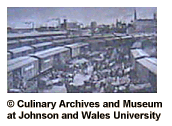 Many food experts claim that chili is the national American dish, not apple pie? Craig Claiborne of the New York Times has written: In one form or another, chili in America knows no regional boundaries... almost every man, woman, and child has a favorite recipe. While chili powder was developed by a German immigrant in New Braunfel, Texas, in 1802, chili con carne probably was invented after the Civil War in San Antonio, Texas.
Many food experts claim that chili is the national American dish, not apple pie? Craig Claiborne of the New York Times has written: In one form or another, chili in America knows no regional boundaries... almost every man, woman, and child has a favorite recipe. While chili powder was developed by a German immigrant in New Braunfel, Texas, in 1802, chili con carne probably was invented after the Civil War in San Antonio, Texas.  S.O.B. stew was the biggest treat during cattle drives? Ingredients were various organ meats and calf parts: brain, head, liver, sweetbreads, tongue, and especially marrow gut, the latter providing the flavor and said to represent the soul of the calf. S.O.B. stew was seasoned with salt and pepper, sometimes skunk eggs (slang term for onion).
S.O.B. stew was the biggest treat during cattle drives? Ingredients were various organ meats and calf parts: brain, head, liver, sweetbreads, tongue, and especially marrow gut, the latter providing the flavor and said to represent the soul of the calf. S.O.B. stew was seasoned with salt and pepper, sometimes skunk eggs (slang term for onion). 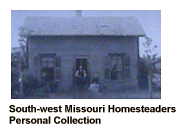 Chuck wagon cooks were traditionally called a range of slang terms, among them: bean master, belly cheater, biscuit roller, boiler, dough-belly, dough-boxer, dough-puncher, flunky, grease burner, grub spoiler, gut burglar, hash burner, hash slinger, kitchen mechanic, lizard, scorcher, pot rustler, sheffi, sizzler, sourdough, stew builder, stomach robber, and swamper?
Chuck wagon cooks were traditionally called a range of slang terms, among them: bean master, belly cheater, biscuit roller, boiler, dough-belly, dough-boxer, dough-puncher, flunky, grease burner, grub spoiler, gut burglar, hash burner, hash slinger, kitchen mechanic, lizard, scorcher, pot rustler, sheffi, sizzler, sourdough, stew builder, stomach robber, and swamper? 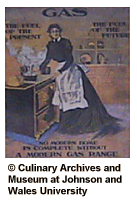 Canned foods were sometimes carried on chuck wagons during cattle drives? On fancier wagons, canned tomatoes were considered the "greatest prize of all." Sometimes, cowboys carried cans of tomatoes while on the range to cut their thirst. It can be argued that tomato juice certainly tasted better than water from wagon barrels that often was alkaline and "wiggling with wildlife."
Canned foods were sometimes carried on chuck wagons during cattle drives? On fancier wagons, canned tomatoes were considered the "greatest prize of all." Sometimes, cowboys carried cans of tomatoes while on the range to cut their thirst. It can be argued that tomato juice certainly tasted better than water from wagon barrels that often was alkaline and "wiggling with wildlife." 